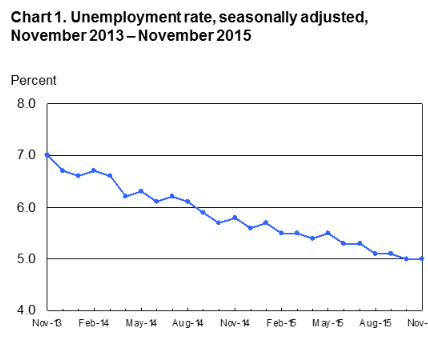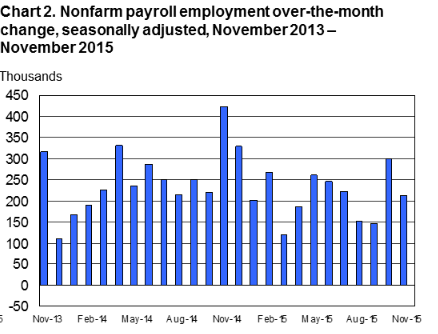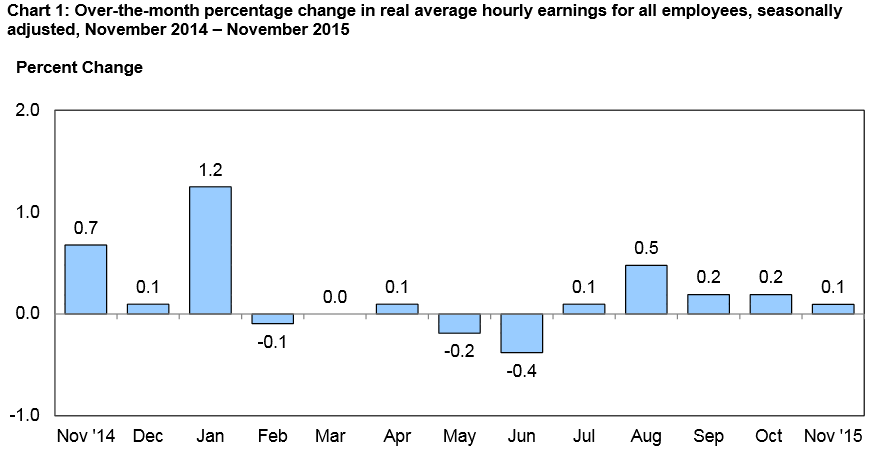Employment blog December 2015
This employment report is taken from the U S Department of Labor, Bureau of Labor Statistics. Total nonfarm payroll employment increased by 211,000 in November, and the unemployment rate was unchanged at 5.0 percent. Job gains occurred in construction, professional and technical services,and health care. Employment declined in mining and information. Incorporating revisions for September and October, which increased nonfarm payroll employment by 35,000, monthly job gains have averaged 218,000 over the past 3 months. In the 12 months prior to November, employment growth averaged 237,000 per month. This information is summarized in Charts 1 and 2 below.
Among the major worker groups, the unemployment rates for adult men (4.7 percent), adult women (4.6 percent), teenagers (15.7 percent), whites (4.3 percent), blacks (9.4 percent), Asians (3.9 percent), and Hispanics (6.4 percent) showed little or no change in November. The number of long-term unemployed (those jobless for 27 weeks or more) was little changed at 2.1 million in November and has shown little movement since June. In November, these individuals accounted for 25.7 percent of the unemployed. The civilian labor force participation rate, at 62.5 percent, changed little in November. The employment-population ratio was unchanged at 59.3 percent and has shown little movement since October 2014. The number of persons employed part time for economic reasons(sometimes referred to as involuntary part-time workers) increased by 319,000 to 6.1 million in November, following declines in September and October. These individuals, who would have preferred full-time employment, were working part time because their hours had been cut back or because they were unable to find a full-time job. Over the past 12 months, the number of persons employed part time for economic reasons is down by 765,000.
Total nonfarm payroll employment rose by 211,000 in November, about in line with the average monthly gain of 237,000 over the prior 12 months. In November, job growth occurred in construction, professional and technical services, and health care. Employment in mining and information declined over the month. Employment in construction rose by 46,000 in November, with much of the increase occurring in residential specialty trade contractors (+26,000). Over the past year, construction employment has grown by 259,000.
In November, professional and technical services added 28,000 jobs. Job gains occurred in accounting and bookkeeping services (+11,000), and employment in computer systems design and related services continued to trend up (+5,000). Over the year, professional and technical services has added 298,000 jobs.
Healthcare employment increased by 24,000 over the month, following a large gain in October (+51,000). In November, hospitals added 13,000 jobs. Health care employment has grown by 470,000 over the year.
Employment in food services and drinking places continued to trend up in November (+32,000) and has risen by 374,000 over the year.
Retail trade employment continued to trend up in November (+31,000) and has increased by 284,000 over the year. In November, job gains occurred in general merchandise stores (+12,000) and motor vehicle and parts dealers (+9,000). Over the past 12 months, these industries have added 85,000 jobs and 71,000 jobs, respectively.
Employment in mining continued to decline in November (-11,000), with losses concentrated in support activities for mining (-7,000). Since a recent peak in December 2014, employment in mining has declined by 123,000.
Information lost 12,000 jobs over the month. Within the industry, employment in motion pictures and sound recording decreased by 13,000 in November but has shown little net change over the year.
Employment in other major industries, including manufacturing, wholesale trade, transportation and warehousing, financial activities, and government, changed little over the month.
Real average hourly earnings increased 1.8 percent, seasonally adjusted, from November 2014 to November 2015. The increase in real average hourly earnings, combined with a 0.3-percent decrease in the average workweek, resulted in a 1.6-percent increase in real average weekly earnings over this period. This information is summarized in Chart1a below.


